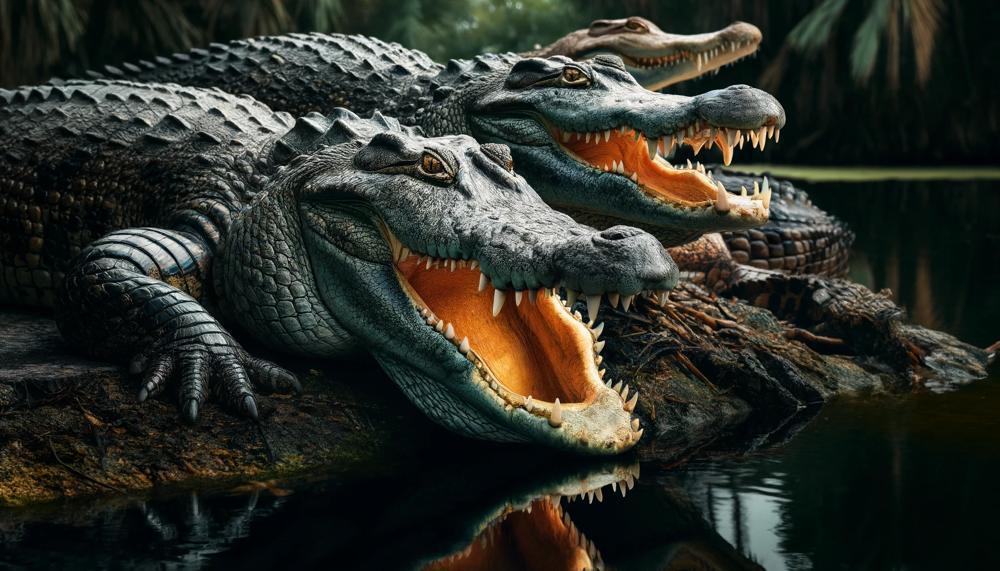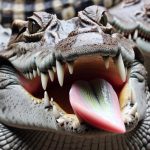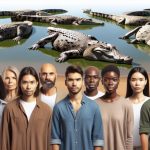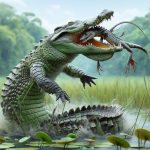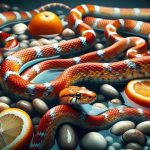In the heart of Florida’s sun-drenched landscape, amidst the swaying palm trees and sprawling wetlands, a surprising inhabitant lurks – the American crocodile. Though many associate this ancient reptile with the remote stretches of Africa or Australia, an estimated 2,000 crocodiles call Florida home, defying the common misconception that only alligators roam the Sunshine State. This revelation serves as a testament to Florida’s rich biodiversity and the crocodile’s resilience.
In this article, we dive deep into the world of Florida’s crocodiles, uncovering the mysteries of their survival and coexistence with humans. We’ll explore how these creatures have adapted to life in Florida, the conservation efforts to protect them, and what their presence means for the ecosystem and local communities.
So, do crocodiles live in florida?
Yes, crocodiles do live in Florida! In fact, the American crocodile is native to Florida. They are usually found in coastal areas throughout the Caribbean, and occur at the northern end of their range in south Florida. They live in brackish or saltwater areas, and can be found in ponds, coves, and creeks in mangrove swamps.
The Florida Fish and Wildlife Conservation Commission estimated the number of Florida crocodiles have increased to as many as 1,500 to 2,000 adults, coming back from an estimated 300 in 1975. The Florida population of this native species is classified as threatened by the U.S. Fish and Wildlife Service.
Crocodiles are considered shy and reclusive. They control their body temperature by basking in the sun, or moving to areas with warmer or cooler air or water temperatures. Their diet primarily consists of small mammals, birds, frogs, turtles, and fish.
There are places in Florida where you can see crocodiles, like the Everglades Alligator Farm and the Crocodile Lake National Wildlife Refuge. But remember, it’s important to respect these creatures and their habitats. Always observe them from a safe distance.
Contents
- 1 What Is The Difference Between A Crocodile And An Alligator?
- 2 Are There Crocodiles in Florida?
- 3 Are There Crocodiles In The Everglades National Park?
- 4 Why Do Crocodiles Live At The Turkey Point Power Plant In Miami?
- 5 Do Crocodiles Live In The Florida Keys?
- 6 Where Is The Crocodile National Wildlife Refuge?
- 7 What Crocodiles Live At The Rookery Bay In Naples?
- 8 Has A Crocodile Ever Made It All The Way Up To Tampa Bay?
- 9 Are There Nile Crocodiles In Florida?
- 10 Are There Crocodiles Living At The Sanibel Island Golf Club?
- 11 Conclusion
What Is The Difference Between A Crocodile And An Alligator?
| Feature | Crocodile | Alligator |
| Snout Shape | Longer, narrower, V-shaped | Broad, shorter, U-shaped |
| Visible Fourth Tooth | Yes, visible when mouth is closed | No, hidden under upper lip |
| Diet | Prefers fish and small prey | Opts for larger mammals |
| Aggression Level | More aggressive and territorial | Relatively docile, less aggressive |
| Social Structure | More solitary, territorial during mating | Lives in groups, or “congregations” |
| Habitat Preference | Adaptable to freshwater and saltwater | Prefers freshwater environments |
| Human Interaction | More likely to attack humans unprovoked | Attacks mostly defensive or accidental |
Crocodiles flaunt a longer, more tapered snout, a bit like a V, suited for snatching fish and small critters. Their jawline showcases a fourth tooth, peeking out when they clamp their mouths shut. They’re the rowdy types, staking their claim and not shying away from a tussle, especially when wooing their mates.
Alligators, on the flip side, sport a broader, shorter snout, more U-like, ideal for chomping down on larger mammals. Their fourth tooth plays hide and seek, not seen when their mouths are closed. Alligators are the chiller cousins, hanging out in groups and steering clear of saltwater, sticking to the freshwater haunts.
Crocs have a bit of a wanderlust, feeling at home in both salty and fresh waters. They’re the gutsy ones, sometimes chasing after humans without a nudge. Gators, though? They’d rather keep to themselves unless really stirred up.
So, while they might share a family tree, crocodiles and alligators live worlds apart in habits and homes.
Are There Crocodiles in Florida?
Yes, crocodiles do indeed dwell in Florida. Now, let’s delve into the species found in the Sunshine State and their typical habitats.
Crocodile Species in Florida
Florida’s warm climes and abundant waterways provide an ideal environment for two distinct species of crocodiles:
- American Crocodile (Crocodylus acutus): This is the native species, deeply rooted in Florida’s ecological tapestry.
- Nile Crocodile (Crocodylus niloticus): A non-native, imposing guest, likely introduced through less-than-legal means.
Where Are They Found?
Let’s break it down:
| Crocodile Species | Key Habitats in Florida | Notes |
| American Crocodile | Everglades National Park, Florida Keys, Biscayne Bay, Coastal Areas | Thrives in both freshwater and saltwater, flourishing thanks to conservation efforts. |
| Nile Crocodile | Everglades | Invasive species, posing a threat to the native ecosystem. Removal efforts are ongoing. |
Are There Crocodiles In The Everglades National Park?
Yes, the Everglades National Park is a sanctuary for the American crocodile, marking it a spot where you’re fairly likely to catch a glimpse of these impressive creatures in their natural setting.
But, just how likely are you to spot one, and what should you do to stay safe while you’re marvelling at the park’s stunning landscapes? Let’s dive in, shall we?
Likelihood of Encountering Crocodiles
Given that around 2,000 American crocodiles call the Everglades home, your chances of seeing one are more than just a shot in the dark.
These critters are particularly fond of lounging in the park’s freshwater expanses, though they’re not shy about sauntering into brackish or saltwater areas either.
So, keep your eyes peeled, especially near lakes, ponds, and canals.
Precautions for Park Visitors
Encounters with crocodiles, while rare, are not unheard of. To make sure your adventure doesn’t take an unwanted turn, here are a few pointers:
| Precaution | Details | Why It’s Important |
| Keep Your Distance | Stay well back from the water’s edge and never approach a crocodile. | Avoids provoking the animals or being mistaken for food. |
| No Feeding | Feeding crocodiles is a big no-no. | Feeding alters their natural behavior and increases danger to humans. |
| Calm Retreat | If you spot a crocodile, back away slowly; no sudden movements. | Reduces the likelihood of triggering an aggressive response. |
| Heed Warnings | Pay attention to park signs and closures. | These are put up for your safety, based on recent sightings and activities. |
Remembering the Role of Crocodiles
While they might give you a bit of a fright, crocodiles are a crucial part of the Everglades’ ecological tapestry. By following the guidelines and respecting these ancient creatures’ space, you contribute to the harmony between humans and nature in this unique landscape.
In short, while the chance of coming face-to-face with a crocodile in the Everglades National Park is real, a bit of knowledge and caution can ensure that your visit is safe and enjoyable.
Why Do Crocodiles Live At The Turkey Point Power Plant In Miami?
Crocodiles are fascinating creatures, and their choice of habitat at the Turkey Point Power Plant in Miami offers a window into their survival strategies. Let’s delve into why these majestic reptiles are drawn to this particular location.
Ideal Habitat Conditions
The Turkey Point Power Plant has inadvertently created a paradise for American crocodiles. The key factors attracting them include:
- Warm Waters: The plant discharges warm water, making the surrounding waters balmy. Crocodiles, being ectothermic, thrive in this warmth which helps in regulating their body temperature.
- Abundant Food Supply: These waters are rich in fish and aquatic wildlife, offering a plentiful buffet for these opportunistic predators.
- Nesting Grounds: Surrounded by mangrove forests, the area provides secluded and protected spaces for crocodiles to lay their eggs and nurture their young.
- Varied Water Access: The location’s proximity to both freshwater and saltwater environments is ideal for the crocodile’s life cycle and hunting habits.
- Human Activity: Activities like fishing and boating often leave behind scraps that further attract crocodiles seeking an easy meal.
Understanding Crocodile Behavior
Crocodiles at Turkey Point exhibit interesting behaviors shaped by their environment:
- Thermoregulation: They bask in the warm water discharge for temperature control.
- Hunting Strategies: These reptiles take advantage of the plentiful fish around the plant.
- Nesting Habits: The mangroves offer safe havens for eggs and hatchlings.
Interconnected Ecosystem
This habitat illustrates the interconnectedness of ecosystems. The power plant’s operations have unintentionally benefited the crocodile population, demonstrating how industrial and natural environments can coexist.
Human-Crocodile Interaction
While this coexistence is fascinating, it’s crucial to maintain respectful boundaries to ensure the safety of both humans and crocodiles.
Table: Key Attraction Factors at Turkey Point
| Factor | Benefit to Crocodiles | Impact |
| Warm Waters | Regulates body temperature | Creates a comfortable living environment |
| Abundant Food Supply | Easy access to prey | Enhances survival and growth |
| Nesting Grounds | Safe place for eggs and young | Supports population growth |
| Varied Water Access | Adaptability to different environments | Aids in hunting and habitat preference |
| Human Activity | Additional food sources | Attracts more crocodiles |
Do Crocodiles Live In The Florida Keys?
Yes, the Florida Keys are home to known habitats of the American crocodile, where these formidable reptiles thrive. Let’s delve a bit into the details of their presence in this archipelago.
The Habitat of Crocodiles in the Florida Keys
The Keys offer a blend of freshwater and saltwater environments, creating ideal conditions for the American crocodile (Crocodylus acutus).
These areas provide everything crocodiles need: plenty of food, warm waters, and secluded nesting sites.
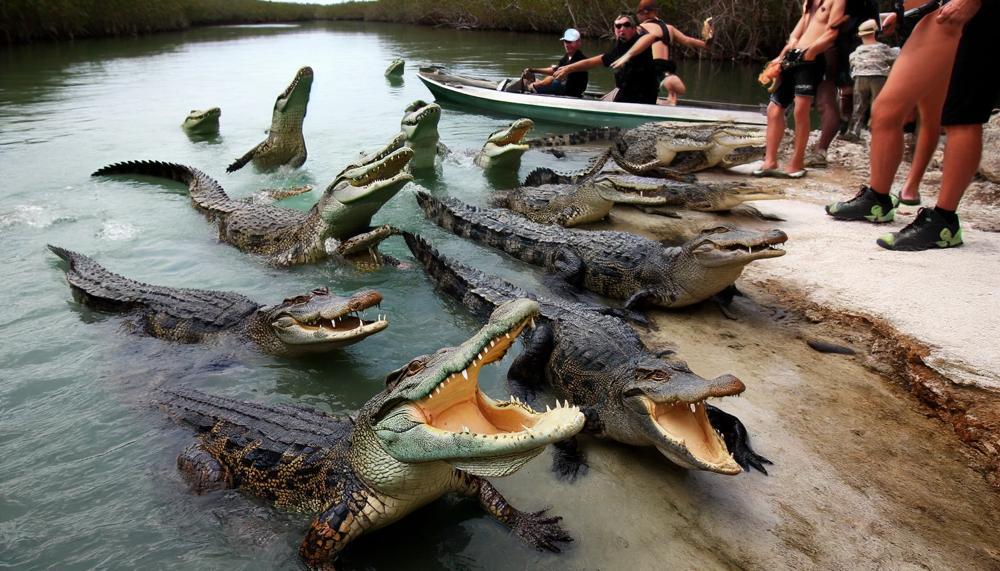
Known Locations and Sightings
Crocodiles have been frequently spotted in areas around Key Largo and Key Biscayne, with the numbers reportedly on the rise over the past four decades.
This increase is a testament to successful conservation efforts aimed at protecting these ancient creatures and their habitats.
Why the Florida Keys?
The unique ecological makeup of the Florida Keys, combining both freshwater and saltwater, attracts crocodiles for its ample food sources and nesting areas.
Conservation and habitat restoration efforts across Florida have contributed to the crocodile’s resurgence, making the Keys a significant part of their recovery story.
Conservation Efforts
The Florida Fish and Wildlife Conservation Commission (FWC) plays a crucial role in monitoring and protecting crocodile populations in the Keys.
Through regulations and protective measures, they ensure the safety of both crocodiles and humans.
Encounters and Safety
While encounters with crocodiles in the Florida Keys are relatively rare, it’s crucial for locals and visitors to stay vigilant and respect wildlife regulations. Awareness and understanding of crocodile habitats can help ensure peaceful coexistence.
| Location | Significance | Conservation Status |
| Key Largo | Nesting and feeding grounds | Monitored by FWC |
| Key Biscayne | Historical sightings; increased presence | Protected habitat |
| Everglades National Park | Adjacent habitat with significant population | Conservation success story |
Where Is The Crocodile National Wildlife Refuge?
The Crocodile National Wildlife Refuge, an essential haven for the American crocodile, is nestled in southern Florida’s renowned Everglades National Park. This vital refuge lies within Miami-Dade and Monroe Counties, covering an expansive area of over 1.5 million acres.
Established in 1975, its core mission is to safeguard the endangered American crocodile and its habitat.
Exact Location
The precise coordinates of the Crocodile National Wildlife Refuge are 25°30’N, 80°50’W. It’s a destination reachable by various routes:
- By car: Via the Tamiami Trail (U.S. Highway 41) and the Shark Valley entrance.
- By boat: Through the Gulf Coast Visitor Center or Flamingo Visitor Center.
Understanding Its Significance
This refuge is a crucial part of the “River of Grass,” the Everglades ecosystem’s nickname, which harbors an incredible range of flora and fauna, including the crocodiles.
Its significance stems from offering protected nesting grounds crucial for the survival of American crocodiles. These coastal areas provide an ideal environment for laying and hatching eggs.
| Feature | Description |
| Climate | Warm, subtropical temperatures essential for crocodiles |
| Habitat | Mix of freshwater and saltwater, rich in food sources |
| Wildlife Diversity | Home to alligators, manatees, over 350 bird species |
| Recreational Activities | Hiking, fishing, boating, wildlife viewing |
What Crocodiles Live At The Rookery Bay In Naples?
Certainly. Rookery Bay in Naples, Florida, serves as a critical habitat for the majestic American crocodile. This elusive reptile, primarily nestled in the southern reaches of Florida, thrives in the unique ecosystem that Rookery Bay provides.
Below is a detailed table highlighting the specifics of the American crocodile’s presence in Rookery Bay:
| Characteristic | Description | Significance |
| Species | American Crocodile (Crocodylus acutus) | Indigenous to Florida, showcasing nature’s resilience and adaptation. |
| Habitat | Brackish and saltwater areas of Rookery Bay | Essential for their survival and growth, contributing to the bay’s biodiversity. |
| Conservation Status | Protected in Florida | Efforts have led to a positive uptick in their numbers, ensuring ecological balance. |
| Diet | Fish, crustaceans, and small mammals | Indicative of their role as apex predators, maintaining the health of aquatic ecosystems. |
| Interaction with Humans | Minimal; crocodiles are shy and avoid humans | Highlights the importance of respecting wildlife spaces and observing from a distance. |
The presence of the American crocodile in Rookery Bay is a testament to the successful conservation efforts in Florida. These reptiles, once teetering on the brink of extinction, have found a safe haven in places like Rookery Bay, where they contribute to the rich tapestry of life that defines this unique ecosystem.
It’s imperative for visitors and residents alike to follow safety guidelines when in crocodile habitats, ensuring peaceful coexistence and the continued prosperity of these ancient creatures.
Has A Crocodile Ever Made It All The Way Up To Tampa Bay?
Answer: To date, there are no verified reports of American crocodiles reaching Tampa Bay. The typical habitat for these crocodiles spans the southern tip of Florida, predominantly within brackish and saltwater environments.
Recent sightings, however, have stirred interest as they have been spotted as far north as Brevard County. This unexpected northward drift could suggest a shift in their natural range, potentially due to environmental changes or shifts in prey availability.
Crocodile Sightings in Florida: An Overview
Crocodiles are generally reclusive and prefer the warmer waters of southern Florida. Here’s a summary of their sightings:
| Location | Date | Significance |
| Rookery Bay, Naples | Ongoing | Established population thriving due to conservation efforts. |
| Brevard County | 2019, 2022 | Farthest northern confirmed sighting, indicating possible range expansion. |
Likelihood and Implications of a Crocodile in Tampa Bay
While the idea of a crocodile making it all the way to Tampa Bay seems far-fetched, changing ecological dynamics cannot be ignored. Here are factors that could influence such a movement:
- Temperature Tolerance: Crocodiles are sensitive to colder temperatures prevalent in northern regions, which historically limited their range.
- Human Encroachment: Urban development can push wildlife into non-traditional areas.
- Prey Movements: Changes in prey species due to environmental factors could lead crocodiles to new areas.
Considering these elements, the presence of a crocodile in Tampa Bay, while currently unlikely, could become a possibility if these trends continue.
This would also mean new interactions between crocodiles and alligators, species that usually coexist without direct competition.
Are There Nile Crocodiles In Florida?
In the sun-drenched swamps and languid lakes of Florida, the tale of the Nile crocodile unfurls like a mystery novel. These formidable creatures, apex predators in their native lands, are indeed rare guests in the Floridian landscape.
| Aspect | Detail | Implication |
| Occurrences | Few confirmed cases | While sightings are rare, each one is a ripple in the waters, hinting at a potentially larger story. |
| Status | Threatened Species (IUCN) | These crocs are hanging by a thread globally, making their presence in Florida a conservationist’s puzzle. |
| Potential Threat | High | Given their diet, Nile crocodiles could unsettle the local ecosystem, threatening native species and humans alike. |
| Lifespan | Up to 45 years in the wild, 60 in captivity | Their longevity suggests that, once settled, they could establish a long-term presence. |
In the few instances where these crocodiles have been confirmed, it’s been through rigorous DNA analysis, hinting that their foothold, while currently minimal, could expand. Their adaptability and diet – ranging from deer to the occasional alligator – mark them as potential disruptors to Florida’s ecological balance.
Stories of crocodiles, like the infamous Gustave, weave into this narrative cautionary threads about the danger and resilience of Nile crocodiles. Yet, their rarity in Florida also opens a chapter on vigilance and the need for ongoing research to understand and mitigate any future impacts.
So, to answer the question: Nile crocodiles are indeed a rare species in Florida.
Are There Crocodiles Living At The Sanibel Island Golf Club?
The query about the likelihood of encountering crocodiles while enjoying a game of golf at the Sanibel Island Golf Club in Florida taps into a fascinating aspect of local wildlife interactions. Let’s cut straight to the chase.
The chance of stumbling upon a crocodile at the Sanibel Island Golf Club is notably slim but not impossible. Given the crocodile’s rare appearances alongside their alligator cousins on Sanibel Island, golfers should consider such an encounter a peculiar event rather than an expected occurrence.
Understanding Crocodile Sightings
Sanibel Island, a serene spot known for its splendid natural beauty, occasionally plays host to crocodiles. However, these instances are as scarce as hens’ teeth, making every sighting a notable event.
The table below offers a glimpse into the comparison of crocodile and alligator sightings in the area:
| Animal | Frequency of Sightings | Location Tendency |
| Crocodile | Extremely Rare | Isolated Spots |
| Alligator | Common | Water Hazards and Ponds |
What This Means for Golfers
For those planning to hit the links at Sanibel Island Golf Club, here’s the lowdown:
- Stay Vigilant: Though a crocodile sighting might be akin to finding a needle in a haystack, maintaining awareness around water hazards isn’t a bad idea.
- Enjoy the Unusual: If you’re among the lucky few to spot a crocodile, remember, it’s a rare brush with wild Florida. Enjoy the moment from a safe distance.
- Focus on the Game: The odds are in your favor that the most thrilling part of your golf game won’t be wildlife-related. So, keep your eye on the ball and enjoy one of Florida’s picturesque courses.
Conclusion
When you go into the lush landscapes of Florida, you’ll find a world where ancient skills meet modern marvels. Even though its cousins, the alligators, get all the attention, the American crocodile has its own place in this biodiverse paradise. This story flows through Florida’s natural fabric to demonstrate not only that the crocodile exists, but also that it does very well thanks to the state’s caring conservation efforts.
These old animals have made Florida’s fabric more interesting. From the salty water of the Everglades to the marshes along the coast, alligators are more than just survival. They are a symbol of strength and flexibility. Their story in Florida is an interesting part of the story of successful conservation, showing how difficult it is to keep wildlife preserves and human neighborhoods in balance. Crocodiles play an important part in the environment, and this balance makes sure that they can keep doing well.
The journey of the American crocodile in Florida is a model for environmentalists, showing how people and nature can live together in peace. Their homes, which range from the saltwater entrances to the Florida Keys to the warm release waters of Turkey Point Power Plant, show that this balance is present. This story not only praises the crocodile’s strength in the past, but it also gives us hope for its future.
As guardians of this world, it is our job to keep making sure that places like these can survive for these beautiful animals.

